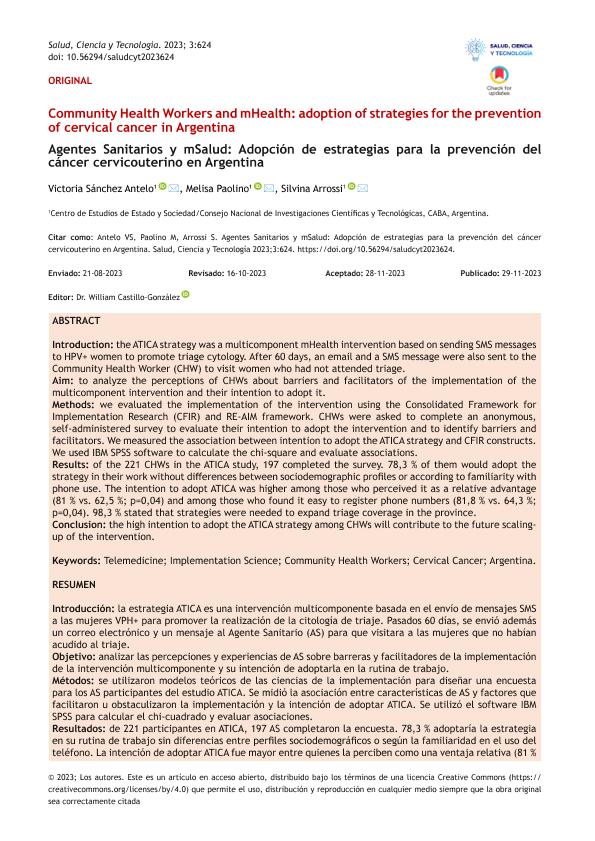Artículo
Introducción: La estrategia ATICA es una intervención multicomponente basada en el envío de mensajes SMS a las mujeres VPH+ para promover la realización de la citología de triaje. Pasados 60 días, se envió además un correo electrónico y un mensaje al Agente Sanitario (AS) para que visitara a las mujeres que no habían acudido al triaje. Objetivo: Analizar las percepciones y experiencias de AS sobre barreras y facilitadores de la implementación de la intervención multicomponente y su intención de adoptarla en la rutina de trabajo. Métodos: Se utilizaron modelos teóricos de las ciencias de la implementación para diseñar una encuesta para los AS participantes del estudio ATICA. Se midió la asociación entre características de AS y factores que facilitaron u obstaculizaron la implementación y la intención de adoptar ATICA. Se utilizó el software IBM SPSS para calcular el chi-cuadrado y evaluar asociaciones. Resultados: De 221 participantes en ATICA, 197 AS completaron la encuesta. 78,3% adoptaría la estrategia en su rutina de trabajo sin diferencias entre perfiles sociodemográficos o según la familiaridad en el uso del teléfono. La intención de adoptar ATICA fue mayor entre quienes la perciben como una ventaja relativa (81% vs. 62,5%; p=0,04) y entre quienes fue fácil registrar el teléfono de la mujer (81,8% vs. 64,3%; p=0,04). 98,3% afirmó que se requieren estrategias para ampliar la cobertura de triaje en la provincia (hay tensión al cambio). Conclusión: La alta intención de adoptar la estrategia ATICA entre los AS contribuirá al futuro escalamiento de la intervención. Introduction: the ATICA strategy was a multicomponent mHealth intervention based on sending SMS messages to HPV+ women to promote triage cytology. After 60 days, an email and a SMS message were also sent to the Community Health Worker (CHW) to visit women who had not attended triage. Aim: to analyze the perceptions of CHWs about barriers and facilitators of the implementation of the multicomponent intervention and their intention to adopt it. Methods: we evaluated the implementation of the intervention using the Consolidated Framework for Implementation Research (CFIR) and RE-AIM framework. CHWs were asked to complete an anonymous, self-administered survey to evaluate their intention to adopt the intervention and to identify barriers and facilitators. We measured the association between intention to adopt the ATICA strategy and CFIR constructs. We used IBM SPSS software to calculate the chi-square and evaluate associations. Results: of the 221 CHWs in the ATICA study, 197 completed the survey. 78,3 % of them would adopt the strategy in their work without differences between sociodemographic profiles or according to familiarity with phone use. The intention to adopt ATICA was higher among those who perceived it as a relative advantage (81 % vs. 62,5 %; p=0,04) and among those who found it easy to register phone numbers (81,8 % vs. 64,3 %; p=0,04). 98,3 % stated that strategies were needed to expand triage coverage in the province. Conclusion: the high intention to adopt the ATICA strategy among CHWs will contribute to the future scalingup of the intervention.
Agentes Sanitarios y mSalud: Adopción de estrategias para la prevención del cáncer cervicouterino en Argentina
Título:
Community Health Workers and mHealth: Adoption of strategies for the prevention of cervical cancer in Argentina
Fecha de publicación:
11/2023
Editorial:
Salud, Ciencia y Tecnología
Revista:
Salud, Ciencia y Tecnología
ISSN:
2796-9711
Idioma:
Español
Tipo de recurso:
Artículo publicado
Clasificación temática:
Resumen
Archivos asociados
Licencia
Identificadores
Colecciones
Articulos(SEDE CENTRAL)
Articulos de SEDE CENTRAL
Articulos de SEDE CENTRAL
Citación
Sánchez Antelo, Victoria Inés María; Paolino, Melisa Delia; Arrossi, Silvina; Agentes Sanitarios y mSalud: Adopción de estrategias para la prevención del cáncer cervicouterino en Argentina; Salud, Ciencia y Tecnología; Salud, Ciencia y Tecnología; 3; 624; 11-2023; 1-12
Compartir
Altmétricas




